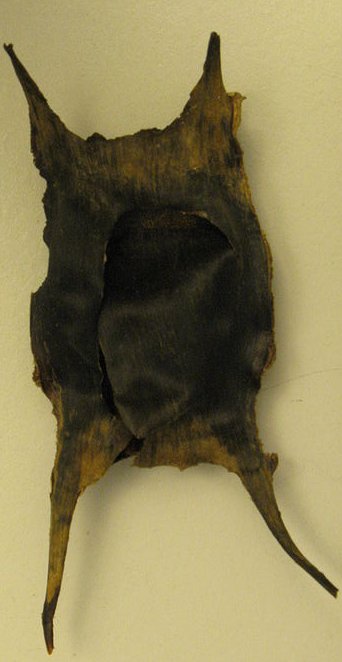"Mermaid's purses (also known as Devil's Purses) are the egg cases of skates, sharks and rays. They are among the common objects which are washed up by the sea. Because they are lightweight, they are often found at the furthest point of the high tide. The eggcases that wash up on beaches are usually empty, the young fish having already hatched out." (Wikipedia)
5. The card in Urania's Mirror has only a hint, with no foot threatening from above. But the foot may have been there already - the first of the 4 legs on the top side of Scorpius seems dislocated:
I think this Sign is in the G text too:
In the important day 260 after equinox there is a creature with 4 legs at left and 3 at right - there is a member missing (reminding us of the spring planter Kuukuu who was a member gone missing from the team of explorers, after having been dealt a blow from above). But the type of glyph (ika hiku) has no other obvious resemblance with a scorpion. This is the beginning of the summary page for ika hiku in my glyph type dictionary:
The Mermaid's Purse:
When I created my glyph type dictionary I did not realize there was a connection between ika hiku and Scorpius. But from my position of today it is rather clear that Metoro meant Scorpius when he said ika hiku. Ika means fish and hiku means tail - on Easter Island they saw Scorpius as a shark and the curved tail of the shark was its major sign of identification. However, south of the equator the Scorpion was not a sign of the end (the 'tail'), it was the opposite - a sign of the beginning (of summer). To make this clear a picture of a shark's egg would be a proper Sign. Such an empty egg case was typically found high up on the beach, as if a junior shark had walked up from the sea and gone into the interior of the island. "Here, in a very condensed form, is a typical Fijian myth of the origin of the current ruling clan (mataqali): A handsome, fair-skinned stranger, victim of an accident at sea, is befriended by a shark who carries him ashore on the south coast of Viti Levu. The stranger wanders into the interior where he is taken in by a local chieftain, whose daughter he eventually marries. From this union springs the line of Noikoro ruling chiefs, the narrator of the story being the tenth descendant on that line. He and his clansmen are called 'The Sharks' (Na Qio)... It is all as in the Hawaiian proverb: 'A chief is a shark that travels on land'... " (Marshall Sahlins: Islands of History.) I cannot remember I have noticed it earlier, but the Fijian Na Qio ('The Sharks') is obviously the plural marker (ga) followed by their word for 'shark' - and I believe it is the same word as the 'Rat' in the kuhane station Te Kioe Uri. | ||||||||||||||||||||||||||||||||||||||||||||||||||||||||||||||||||||||||||||||||





